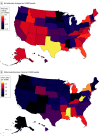Community Pharmacy Turnover and Context of Openings and Closings by Ownership Type
- PMID: 40748545
- PMCID: PMC12317352
- DOI: 10.1001/jamahealthforum.2025.1988
Community Pharmacy Turnover and Context of Openings and Closings by Ownership Type
Abstract
Importance: While community pharmacies provide many valuable prescription and professional services, they are also retail businesses. Evaluating pharmacy closures through the lens of a retail business framework may provide more context on what is happening in this industry and identify potential solutions to address closures and/or shortages.
Objective: To evaluate community pharmacy turnover (openings and closings) in the US over time and by ownership type.
Design and setting: This cross-sectional analysis of all community pharmacy openings and closings in the US from 2010 to 2023 used pharmacy-level data from the US National Council for Prescription Drug Programs database. National-, state-, and county-level turnover was assessed using economic indicators of business dynamics, such as total population, population growth, household income, total firm changes for all industries, and net job creation.
Exposures: Pharmacy class type defined as either a chain pharmacy (4 or more pharmacies under common ownership) or an independent or franchise pharmacy using the US National Council for Prescription Drug Programs classifications.
Main outcomes and measures: Pharmacy turnover rate from 2010 to 2023, calculated as the sum of pharmacy openings and closings over the full study period divided by the total pharmacies in the market at the beginning of the period (2010).
Results: The analyses found that US pharmacy market turnover rate for this 14-year period was 86.8% (52 974 total openings and closures of 61 054 total pharmacies in 2010) or 6.2% annually. When comparing across pharmacy types, independent pharmacy turnover was substantially higher (152.7%) than chain pharmacy turnover (49.9%) across the entire US. Counties with high turnover were associated with net increases in pharmacies from more independent pharmacy openings over the period. Turnover rates for all businesses were higher in counties with both low and high pharmacy turnover, even when adjusting for population size.
Conclusions and relevance: This cross-sectional study found that the community pharmacy market in the US has an annual turnover rate of approximately 6.2%, with independent pharmacies opening and closing more frequently than chain pharmacies.
Conflict of interest statement
Figures



Similar articles
-
Sexual Harassment and Prevention Training.2024 Mar 29. In: StatPearls [Internet]. Treasure Island (FL): StatPearls Publishing; 2025 Jan–. 2024 Mar 29. In: StatPearls [Internet]. Treasure Island (FL): StatPearls Publishing; 2025 Jan–. PMID: 36508513 Free Books & Documents.
-
Vulnerability Index Approach to Identify Pharmacy Deserts and Keystone Pharmacies.JAMA Netw Open. 2025 Mar 3;8(3):e250715. doi: 10.1001/jamanetworkopen.2025.0715. JAMA Netw Open. 2025. PMID: 40080019 Free PMC article.
-
Interventions to reduce non-prescription antimicrobial sales in community pharmacies.Cochrane Database Syst Rev. 2025 Jan 29;1(1):CD013722. doi: 10.1002/14651858.CD013722.pub2. Cochrane Database Syst Rev. 2025. PMID: 39878150
-
Signs and symptoms to determine if a patient presenting in primary care or hospital outpatient settings has COVID-19.Cochrane Database Syst Rev. 2022 May 20;5(5):CD013665. doi: 10.1002/14651858.CD013665.pub3. Cochrane Database Syst Rev. 2022. PMID: 35593186 Free PMC article.
-
Comparison of Two Modern Survival Prediction Tools, SORG-MLA and METSSS, in Patients With Symptomatic Long-bone Metastases Who Underwent Local Treatment With Surgery Followed by Radiotherapy and With Radiotherapy Alone.Clin Orthop Relat Res. 2024 Dec 1;482(12):2193-2208. doi: 10.1097/CORR.0000000000003185. Epub 2024 Jul 23. Clin Orthop Relat Res. 2024. PMID: 39051924
References
-
- Abelson R, Robbins R. The Powerful Companies Driving Local Drugstores Out of Business. The New York Times. October 19, 2024. https://www.nytimes.com/2024/10/19/business/drugstores- closing-pbm-phar...
MeSH terms
LinkOut - more resources
Full Text Sources

